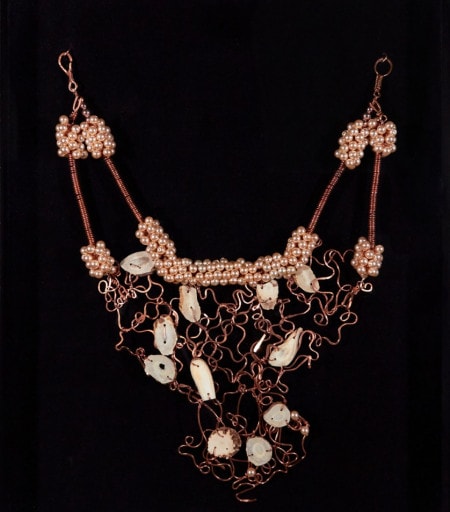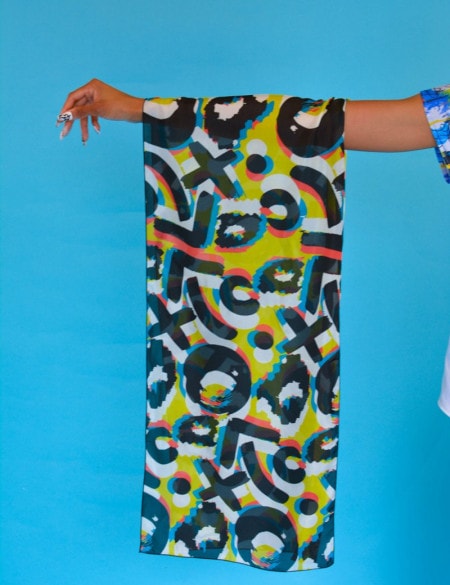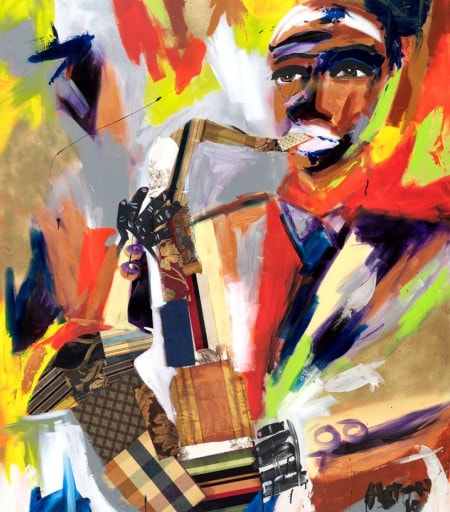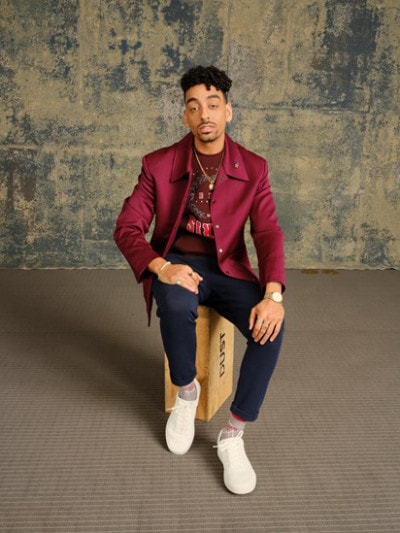‘Bel Air’ TV Show Created by Native Kansas Citian Opens New Vistas for Kansas City Artists Morgan Cooper Hopes to 'Provide a Platform for the Talent in My Hometown'
Published July 5th, 2022 at 6:00 AM
Above image credit: Screenshot of Jason Wilcox’s painting, “Bel-Air Will,” from Episode 10 (Season finale) of "Bel-Air." The painting is a depiction of Jabari Banks (seen from behind at left), who plays Will Smith on the show; Adrian Holmes (right) plays Philip Banks, aka Uncle Phil. (Courtesy | Peacock)The creatives behind the remake of a ’90s sitcom have proven once again that Kansas City artists can play with coastal counterparts on the same field.
“Bel-Air,” a dramatic re-imagining of Will Smith’s “The Fresh Prince of Bel-Air,” debuted on Peacock in February. The brainchild of Morgan Cooper, a filmmaker from the Kansas City area, “Bel-Air” has showcased the works of several Kansas City artists.

“Morgan has always had Kansas City at the heart of what he does,” said Marissa Starke, executive director of the Kansas City Artists Coalition. “From Kansas City he has brought in wardrobe professionals, behind-the-scenes production and art crews, and artists.”
Starke’s husband, Johnny Starke, is the producer and assistant director of “Bel-Air.” In Marissa Starke’s role as a consultant, she recommended 25 artists for the show, of whom eight had been chosen at press time.
Kansas Citians know how talented their city is, “but Kansas City and the Midwest as a whole is underrepresented compared with coastal regions,” Marissa Starke said. “We’re considered flyover area. We’re trying to stamp out that perception. I would argue that Kansas City is at the same level as Los Angeles or New York in terms of its talent pool.”
Starke sought out a wide variety of established Kansas City artists for “Bel-Air.” She knew some of them through exhibitions at the Bruce R. Watkins Cultural Heritage Center at 3700 Dr. Martin Luther King Jr. Blvd. Named after the late Bruce R. Watkins, the first African American elected to the Kansas City Council, the center recognizes and preserves the varied contributions made by African Americans to the development of Kansas City.
For example, Marissa Starke had been impressed with the work of Jason Wilcox when his paintings were featured at a 2019 exhibition at the Watkins Center.
“She contacted Johnny Starke, who connected me with Morgan Cooper,” Wilcox said.

Getting connected with Cooper led to Wilcox’s work being featured in a short film entitled “U SHOOT VIDEOS?” and then “Bel-Air.”
“It’s been an honor to showcase my artwork on a major platform and represent Kansas City at the same time,” Wilcox said. “There are a lot of people in Kansas City involved in this.”
The 2019 Watkins Center exhibition also displayed works by Clarissa Knighten, a jewelry and sculpture artist. Knighten, who formerly held business and information technology positions in the health insurance world, said “Bel-Air” marks a major milestone in her artistic career.
“I never would have thought that after 19 years in corporate America and four years as a full-time artist, I would have work on a TV show that made history,” she said. “I believe I’m being led and pushed, and God is guiding me to higher heights.”
Whitney Manney, a fiber and textile artist, said the “Bel-Air” costume team contacted her in August 2021.
“I’m not sure if somebody referred me,” she said. “But I know Morgan Cooper, the show creator. He did an amazing job of making sure to include as many Kansas City artists as possible. I’m excited that I was one of the artists.”
Manney said her “Bel-Air” exposure has boosted her career, with more orders getting logged on her online shop.

“To be involved with a really big project and have that stamp of approval at this stage of my career, that validation is huge,” she said. “And it’s so nice to be able to see your work on such a big platform.”
Early this year, an email to painter/printmaker Anthony High flagged his painting of a Kansas City jazz trumpeter for “Bel-Air.”
“I was so excited,” High said. “I hoped it was real. My son checked it out and said ‘Dad, I think it’s real.’ This is huge. I’m eternally grateful that Marissa submitted my name.”
High hopes his inclusion will lead to more work, but he said marketing is not his strong point.
“I’m very comfortable with the studio part of this, but I’m kind of inept when it comes to the networking and electronic media part of it. I’ve got my sister working that end in California, and she’s making connections to other groups that show an interest in my artwork. I’m trying to get exposure outside of Kansas City, and slowly but surely, it’s starting to work for me.”
Another artist whose works were chosen for “Bel-Air,” painter and “KC Studio” writer Harold Smith, said artists must employ tech-savvy marketing tools. He said the show’s artistic director picked works that Smith featured on his website and Instagram.

“In the past, shows like ‘The Cosby Show,’ ‘Good Times’ and ‘A Different World’ utilized Black art by people such as Ernie Barnes,” Smith said. “In the digital age, it’s easier for artists to capitalize on their works being used in shows. People can Google the artist and find their websites, etc. My advice would be to maximize social media and create a strong internet presence, since that is how artists are being discovered now.”
Manney said her strong online presence played a role in her “Bel-Air” breakthrough. “The lead costume designer, Fernando Rodriguez, went through my website and sent me screenshots of what he thought would work best.”
Wilcox said artists who want to expand their career horizons should “keep grinding, keep believing in yourself. Keep perfecting your craft and keep doing what you love to do best. This doesn’t come overnight. You’ve got to keep at it. Your time will come.”
Meantime, Cooper has been working on a comedy series about a former basketball star from Kansas City whose dreams of going pro are sidelined by an injury. He becomes a national barista champion and moves back home to open a coffee shop in his old neighborhood, hoping to revive the community.
Stay tuned.
Bel-Air Creator Morgan Cooper Lauds Kansas City Talent
“Every episode of Bel-Air has Kansas City artwork in it, so I’d say it’s worked out very well.”
— Morgan Cooper
Julius Karash: Why did you choose artists from Kansas City for the Bel-Air reboot?
Morgan Cooper: Being from Kansas City, it was very important for me to reach out to the local community and provide a platform for the talent in my hometown. I not only believe in the art that comes from KC, I’m a fan of it myself. Kansas City has a deep and rich history, from fine art to music. I wanted the Banks home and the sets in Bel-Air to carry a piece of Kansas City for the world to see.

JK: How has that worked out?
MC: Every episode of Bel-Air has Kansas City artwork in it, so I’d say it’s worked out very well. It’s created a new audience and a new level of exposure for Kansas City artists to showcase their talent, which is everything I wanted.
JK: Is there an illustrative anecdote you’d like to share about working with Kansas City artists on this venture?
MC: Working with Jason Wilcox has been amazing. Jason did all of the paintings that Viv creates in the show. Jason is so talented and such a thoughtful artist. He’s also driven by story and character, so to collaborate with him in that way was a really fun experience.
JK: Do you think other creative decision makers will follow your example in looking to Kansas City artists?
MC: I absolutely hope people follow my example. It’s important for people to provide a platform for their hometown because there’s incredible art that’s being made in the Midwest. The talent in Kansas City is incredible, so my hope is that people see how bright the city shines.
Flatland contributor Julius A. Karash is a Kansas City-based writer. This article first appeared in KC Studio. It is part of an ongoing content collaboration between Flatland and KC Studio.


